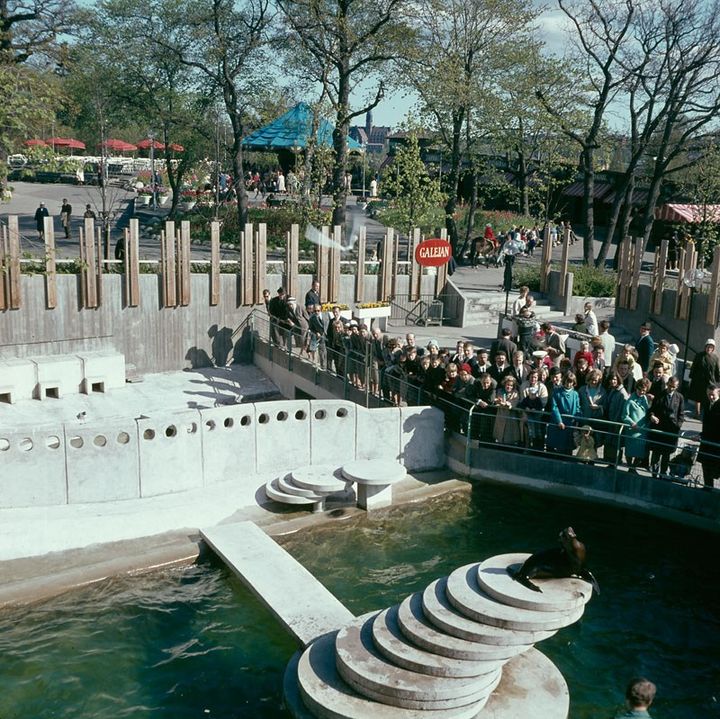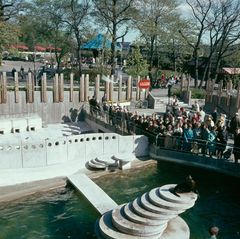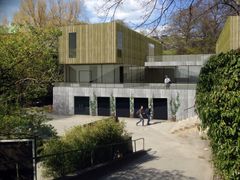Holger Blom’s sea lion terrace becomes the Baltic Sea Science Center

Even at this early stage, it was already clear that there was great potential to create an area with attractive content and spaces for educational activities, and the idea for the Baltic Sea Science Center was born. With a sketch from KAWA, Skansen gave a presentation to the BalticSea2020 Foundation, which decided to come on board as the main financial backer. The outline planning began in autumn 2015.
Following a procurement process, SH Bygg was awarded a turnkey contract in partnership with Skansen. KAWA and Topia were engaged by SH Bygg, together with other consultants, for the continued construction document planning.
“It’s been a fantastic experience helping to create a project with such fascinating and important content, and to do so at one of Sweden’s most popular attractions,” says architect Katarina Wahlström. “It’s also been interesting to have been involved from the start, creating content for the centre together with Skansen, researchers from the knowledge council and experts on aquariums and Baltic issues. The design process has been exciting, focusing on everything from creating exhibition spaces and educational activities to designing aquariums.
“The design of the building has been based on its specific content, and the exterior has been adapted to fit its surroundings. The whole collaboration process really has been both fascinating and rewarding.”
One requirement for the construction project was that it should occupy the former sea lion terrace between Skansen Aquarium and the Galejan Fairground, with its pools, steps and terraces that had fallen into disrepair after so many years of disuse. This was an infill plot in a historic setting, and the building would need to house many functions and highly complex, space-intensive technology in a relatively small area.
The historic 1960s setting is part of the Lower Solliden Park created by architect Holger Blom, which also includes the old Elephant House and the Tropical House, now the Monkey House. The plot features considerable variations in levels, a height difference of around 10 metres, and thoroughfares running around it.
“We’ve designed the centre so that visitors can find different ways to experience it. The plot is on a slope, and we designed the building as a 3D puzzle that connects with its surroundings in different ways. The various levels also build upon the structure of the former construction with its terraces. This creates five different levels, one of which is below ground.
“In terms of the external design, we have taken the concrete architecture of the existing structure as our starting point. The concept combines coarse materials – in-situ concrete and wood, which will turn grey with time – with glass as a contemporary addition. We are also building in a simple yet contemporary style.
“The design is based on a number of elements from the previous structure which have set the tone for the new building. One example is the portico wall where the entrance to the aquarium is positioned.”
In terms of materials, the building can be divided horizontally into three different parts: a base level of in-situ board-cast concrete, a glazed mid-level that faces onto a courtyard area, and two partly cantilevered wood upper sections with an intermediate terrace. The entire building covers an area of around 2,000 m².
Bilder


Om
Mitt på den gröna ön Djurgården i Stockholm finns Skansen. En plats som levandegör upplevelser av natur och kultur – nu, då och i framtiden. Stiftelsen Skansen är världens äldsta friluftsmuseum, grundat 1891 av Artur Hazelius, och varje år kommer cirka 1,4 miljoner gäster till oss.
Följ Stiftelsen Skansen
Abonnera på våra pressmeddelanden. Endast mejladress behövs och den används bara här. Du kan avanmäla dig när som helst.
Senaste pressmeddelandena från Stiftelsen Skansen
Tjolahopp! Nu blir det hyss och skoj på Skansen24.4.2024 07:55:00 CEST | Pressmeddelande
-Den här majhelgen har blivit en riktig tradition och vi är så glada att återigen få bjuda in stockholmarna till Skansen för att träffa Pippi och alla de andra från Astrid Lindgrens värld, säger Max Hallén, VD, Astrid Lindgren Aktiebolag.
Saint-Gobain utökar sitt engagemang i Stiftelsen Skansen18.4.2024 12:00:00 CEST | Pressmeddelande
Saint-Gobain har varit en partner till Skansen sedan 1991. Det är nu klart att de kliver in och utökar sitt engagemang under de kommande tre åren. ”Bevarandet av ett kulturarv rimmar väldigt väl med ett hållbart byggande som är vår ledstjärna inom Saint-Gobain”, säger Annika Westby på Saint-Gobain Sweden.
Uje Brandelius är årets vårtalare på Skansen: “Jag gråter alltid på Valborg”17.4.2024 07:50:00 CEST | Pressmeddelande
Den 30 april firar Skansen traditionsenligt valborg med livemusik, valborgsmässobål till stans bästa utsikt över Stockholm och klassiskt tal till våren. Musikern, skådespelaren och journalisten Uje Brandelius får i år det traditionstunga uppdraget att vårtala.
Svävande pingstliljor, 1700-tal och blomsterpoesi – ny utställning öppnar på Skansen 18 maj9.4.2024 07:50:00 CEST | Pressmeddelande
“Maj är min absolut bästa månad. Naturen vaknar, exploderar och blir fulländad under bara några veckor. Ingen annan tid på året blir buketterna så vackra som nu, i hänryckningens tid”, säger floristen Johan Munter. I maj sätter han sin prägel på Skansens 1700-talsherrgård Skogaholm med utställningen Blomster i hänryckningens tid.
Pirr, parning och party när Skansen bjuder in till Kulturnatt 20243.4.2024 07:50:00 CEST | Pressmeddelande
Skansen bjuder in till en kväll av kärlek, oväntade upplevelser och fest under Kulturnatt Stockholm den 20 april. Djupdyk i djurrikets parningsritualer och historiens kontaktannonser, gå på singel-vandring och dansa loss till countryklubben Sthlm Honky Tonk. Fri entré hela kvällen.
I vårt pressrum kan du läsa de senaste pressmeddelandena, få tillgång till pressmaterial och hitta kontaktinformation.
Besök vårt pressrum
